Australia So Much to See


The Gibb River Road and the West Kimberley 2008 - we start by visiting Geikie Gorge, Tunnel Creek and Windjana Gorge, then joining
the Gibb River Road and visiting Bells Falls.
Early next morning the rising sun caught the surrounding rocks which dwarfed our caravan. Boab trees were silhouetted
against the dawn sky.
During the 1880s and 1890s pastoralists established sheep and cattle stations in the West Kimberley. Aboriginal lands
were taken over, and traditional hunting grounds now grazed sheep or cattle. Some Aborigines found work on the stations, and
one young man, Jandamarra was a boy when his family moved onto Lennard River Station, where he soon became an excellent horseman and
stockman; the best horseman they had seen. When he was fifteen, he returned to his tribe for his initiation and stayed with
them, joining them on raids ‘sheep spearing’ as they resented the sheep which grazed their hunting grounds, competing with the animals
they hunted for food.
In 1889 Jandamarra (known as Pigeon) was arrested for sheep spearing, but recognising his skills as a
horseman, the Derby Police employed him. Together with another Aboriginal tracker named Captain, Police Constable Richardson
and Pigeon formed a very successful unit, capturing a large number of Aborigines
The Lennard River runs through the Napier Range, carving out Windjana Gorge.
In this pool over seventy fresh water crocodiles can be seen basking on the sand banks, or floating with their dragon like tail
spikes above the water.
Starting early in the morning, we took the seven kilometre return walk through gorge, past towering orange cliffs, colonies of noisy
fruit bats, and various birds. Marine fossils can be found in the wall of the gorge.
We spent over three weeks touring from Derby to Kununurra, seeing scenic and fascinating areas. This travelogue takes us
from Derby to the Kalumburu turn off which is roughly half was along the Gibb River Road. The Gibb River Road runs fromDerby to a point between Wyndham and Kununurra and was constructed as a road during the 1950s to transport cattle from the stations
to the abattoirs and ports at Wyndham and Derby.
Before going on the Gibb River Road itself, we took the Great Northern Highway to Fitzroy Crossing to see Geikie Gorge (Danggu),
which is very different to the gorges of the Gibb River Road. Geikie Gorge (Danggu), Tunnel Creek (Dimalurru) and Windjana
Gorge (Bandilngan) are all in a range which is believed to be part of a 350 million year old barrier reef from the Devonian period. The Devonian is a geologic period and system of the Paleozoic Era spanning from 416 to 359.2 million years ago. Unlike
coral formed barrier reefs, this reef was built principally by algae and lime secreting organisms called stromatorapoids. In
some areas corals, shells and fossilised early fish can be seen.
We took the Department of Parks and Wildlife boat tour of Geikie Gorge, as the only way to view the gorge is by boat.
See Schedule. The white area is that mostly under water during the wet season, although levels can vary greatly from year to
year. A mixture of grey, orange and yellow can be seen on the walls which rise up sharply from the water. Erosion
near the water level results in fascinating shapes, looking like carved marble pillars or icebergs.
From Fitzroy Crossing we back tracked a little way to the Leopold Downs Road, which would take us north to other Devonian Reef Parks
of Tunnel Creek (Dimalurru) and Windjana Gorge (Bandilngan), then to the Gibb River Road
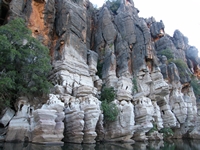
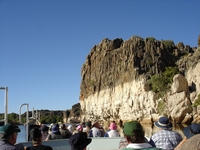
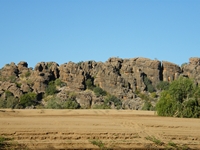
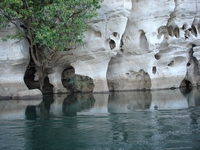
Tunnel Creek is a 750 metre long tunnel through the Napier Range. On entering the cave, coloured rocks reminded me
of the jasper at Marble Bar; splash a bit of across them to bring out the colours. We didn’t find the Aboriginal paintings
in the cave.
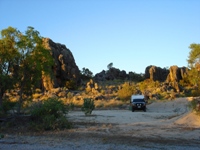
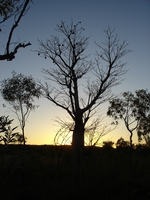
Freshwater crocodiles abound and in the picture to the right, tracks can be seen along the sand from the river where crocodiles have
laid their eggs.
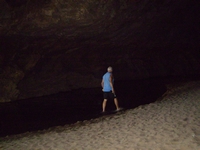
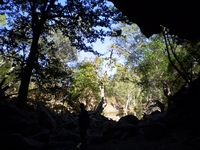
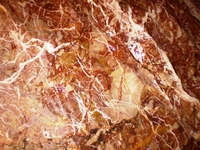
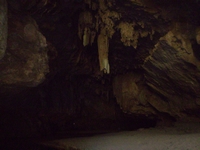
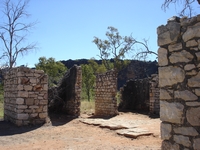
In 1894 Richardson’s unit was transferred to the Napier Range area to engage against the Bunuba; Jandamarra’s own people. Aborigines
were captured, chained and marched to the abandoned Lillimooloora homestead, which the police were using as their headquarters.
The prisoners, all known to Jandamarra and many being related to him, told Pigeon that the Bunuba country was about to be invaded
by Europeans, with three white stockmen bringing 500 cattle up Windjana Gorge to establish a cattle station.
The prisoners demanded Jandamarra release them. Jandamarra then shot Constable Richardson and released the prisoners.
They set up an ambush hiding in caves along Windjana Gorge and shot two of the three stockmen who were bringing the cattle. Jandamarra trained his growing group of followers to use guns, obtained from raids on police stations. Reinforcements of police
were sent from Roebourne to join local police to hunt down these ‘outlaws’. At one stage Jandamarra was wounded and presumed
dead, however he hid and recuperated in Bat Cave (now known as Tunnel Creek). For two more years Jandamarra lead raids on the
police stations before being fatally shot.
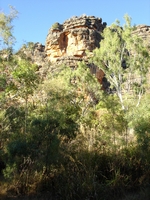
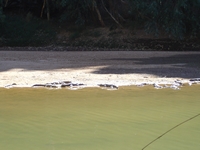
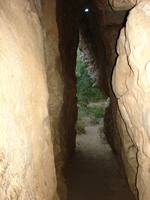
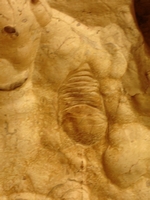
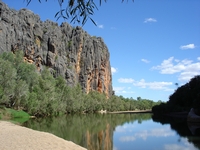
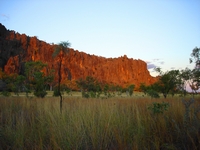
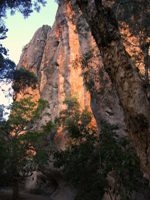
From the camp ground, the setting sun lights up the reef.
Travelling a little further we joined the Gibb River Road near the Lennard River Bridge and continued in a roughly north easterly
direction. Passing through Yammera Gap in the Napier Range there is a distinctive “Queen Victoria’s Head” rock formation. Inglis Gap is at the highest point of the King Leopold Range (since re-named the Wunaamin-Miliwundi Range) crossing. From
here the country changes again. We chose not to go into the Lennard River gorge, as the road and small parking area may
have been awkward for us to access with our caravan (although others with similar rigs have).
The vast Kimberley country, as seen when crossing the King Leopold Range (since re-named the Wunaamin-Miliwundi Range).
Next stop was at Silent Grove (Dulundi), the Department of Environment and Conservation (DEC) camp site for Bell Gorge (Dalmanyi). Both Windjana and Silent Grove are good DPaW campsites in lovely locations. Next morning a short drive and a walk took us to
the picturesque Bell Creek Falls.
To cross the falls involved a walk through shallow fast flowing water at the top of the falls, followed by a rocky climb and descent
to a vantage point to view the falls, and a further climb down a rocky face to a large pool suitable for swimming.
Another vista from the King Leopold Range (since re-named the Wunaamin-Miliwundi Range).
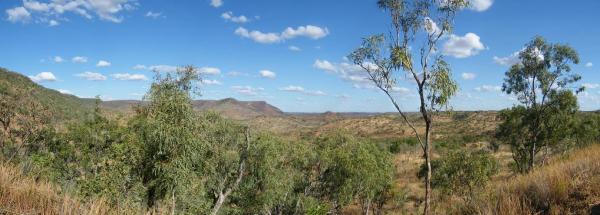
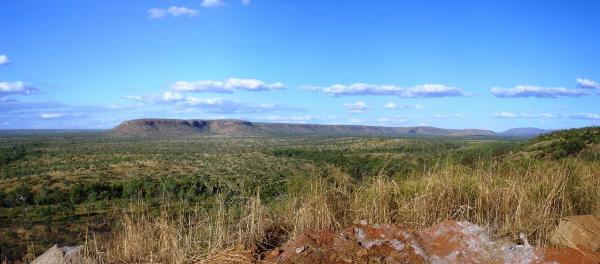
Views of the falls can be gained by climbing on cliffs either side of the creek.
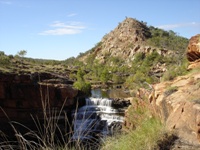
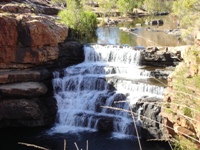

Copyright (C) 2013 AustraliaSoMuchtoSee.com. All rights reserved
Caution is required when looking at the Lillimooloora ruins. The wall are unstable and likely to collapse. Warning signs
and requests to stay a safe distance have been in force for some time. Please consider your safety.
1 May to 31 May 8.30am and 4.00pm
01 June to 30 June 8.00am, 9.30am, 2.30pm and 4.00pm
1 July to 31 July
8.00am, 9.30am, 11.00am, 2.30pm and 4.00pm
1 August to 15 August 8.00am, 9.30am, 2.30pm and 4.00pm
16 August to 15 September
8.00am, 2.30pm and 4.00pm
16 September to October 16 8.00am and 4.00pm
On line bookings currently unavailable. Subject
to availability, tickets can be purchased at the gorge up to 30 minutes prior to departure. Should you wish to make a group
booking or require further information regarding the tours please contact the Parks and Wildlife West Kimberley office in Broome on
(08) 9195 5500. Geikie Gorge Boat Tour.
See also Mimbi Cave, around 95 kilometres south of Fitzroy Crossing via the Great Northern Highway.
























